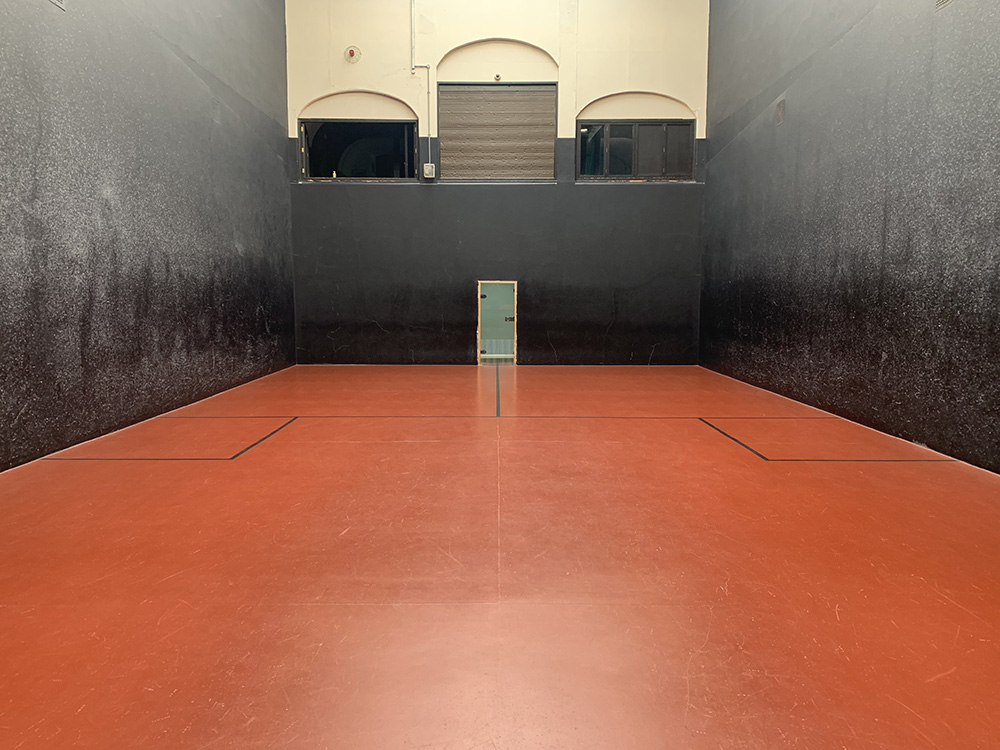Rackets in the British Isles
An insanely fast game that has been played since the nineteenth century.
19th Century
Rackets is now played at 14 Independent Schools, the Queen's Club, Manchester, Seacourt, Dartmouth and Sandhurst.
Harrow were the first public school to play Rackets, developed in the school yard when that was enlarged in 1821. The sixth and fifth forms used the west wall of the Old Schools, with the east wall of the Milling Ground as a back wall; the rest of the school used the high south boundary wall. Two new courts were built at Harrow in 1850 just west of the Milling Ground.
The earliest covered court was built by the Royal Military Academy at their Woolwich Depot. The MCC built a court at Lord’s next to the old Tennis court in 1844, and Prince’s Club opened in Hans Place in 1853 with several Rackets courts.
In 1857 Colonel Lord West built a court at Buckhurst Park, Sussex, to commemorate the capture of Sebastopol, where he had commanded the 21st Royal North British Fusiliers. Joseph Bickley re-faced the walls around 1900. Thanks to the support of Earl de la Warr it remains the only private court in the country.


Both Oxford and Cambridge had courts and this led to the first Varsity match in 1855. This was limited to doubles, but in 1858 a singles match was also played between the first strings. In 1921, two singles matches were played, although the second did not count towards the result until 1937. The first match in 1855 was played at Oxford, but subsequent matches took place at Prince’s until that club was demolished in 1886. The match was played at Manchester in 1887 and thereafter at Queen’s Club.
The Victoria Club, Torquay was built by Henry Day, in 1859. It included a Rackets court as well as billiard and reading rooms. Rackets was popular at first, but interest waned.
There was a court in Rose Street in Edinburgh. In 1864 Prince Alfred, second son of Queen Victoria, was struck in the eye while playing there.
The first covered court at Harrow was opened in 1865 immediately adjoining the open court to the west. It was slightly larger than standard and has recently been reconstructed along more traditional lines.
The Public Schools Rackets championship began in 1868 at Prince’s, was played at Lord’s in 1887 and thereafter at Queen’s, except for 1941 when the final was played at Wellington.
The growing popularity of Rackets led to the building of several club courts: in 1876 two courts at Manchester and in 1888 two others at the new Prince’s Club, Knightsbridge, and two at the Queen’s Club.
In 1877 the Liverpool Racquet Club was opened, with two Rackets courts and a bowling alley. In 1894 the bowling alley was converted into two courts, for Eton fives and Rugby fives, although not long afterwards the latter came to be used for squash.
In Cambridge, Rackets began in open courts attached to public houses. One of these, at the University Arms, was kept by H.J. Gray for eleven years before he went to the East Road (or Wellington) court. In 1858 St John’s College opened two new courts (one open and one closed), which were run by Harry Gray. In 1892, St John’s leased a plot of land. Rackets was also played in Portugal Street from 1887 where two Rackets courts were built but the whole complex has now been demolished.

20th Century
Rackets is now played at 14 Independent Schools, the Queen's Club, Manchester, Seacourt, Dartmouth and Sandhurst.
At the beginning of the century, Rackets courts at Eastbourne, Oxford, Torquay, Newcastle, Liverpool, Leamington and some private courts had gone out of play. Existing in 1914, in addition to those at public schools, were courts at Queen’s (two), Prince’s, Lord’s, University College London, Manchester, Cardiff, Cambridge, RA Woolwich, RMA Woolwich, RE Chatham, BRNC Dartmouth RMC Sandhurst, Aldershot, Colchester and Shorncliffe.
A unique event took place in 1908 when Rackets for the first and last time was included in the London Olympic Games. The competition was played at Queen’s and comprised both singles and doubles.
In 1912 World Champion Charles Williams was on his way to America to play his US challenger George Standing for the World Championship. He sailed on the maiden voyage of the Titanic when she struck an iceberg and sank on 14/15 April 1912, with the loss of 1513 lives. After spending nine hours adrift in a small boat before being rescued, the match was called off. By 1913, Standing had retired and Williams agreed to meet Jock Soutar in a home-and-away match. Soutar won the subsequent match over the two legs.


The end of WW2 led to an increase of Rackets activity and the start of two new competitions. The Army Open Rackets competition was first played in 1946 when the Cosmo Crawley and Peter Cazalet, won a remarkable victory over Geoffrey Atkins and Ronnie Taylor. The following year, Crawley won again, in partnership with Kenneth Wagg, and in 1948, the last year it was played, the winners were Bimby Holt and Kenneth Wagg.
More enduring were the Combined Services (past and present) competitions, first played in 1949, when Geoffrey Atkins won the singles, and the doubles in partnership with Ronnie Taylor. The singles were last played in 1967, but the doubles have continued and have been won by many different pairs.
To mark the end of the Second World War and the revival of Rackets, Cosmo Crawley and Clarry Pell planned a British Rackets team tour of North America to take place in early 1947. The British team were accompanied by Jim Dear, who was on his way to play for the world championship and able to give them invaluable practice, including squash on the Mauritania at sea.
By 1980, there were twelve schools with courts, six of them with two courts. A further six clubs made a total of twenty-four courts. Since then, four courts have been restored at Marlborough, Cheltenham, Newcastle and Queen’s Club, and a new court built at St Paul’s School. Sadly, St John’s College, Cambridge, decided to demolish the Portugal Place complex, so that neither of the varsity universities has a Rackets court, and players depend for practice on Haileybury and Radley. Thus in 2000 there were twenty-eight courts in action in the UK.
